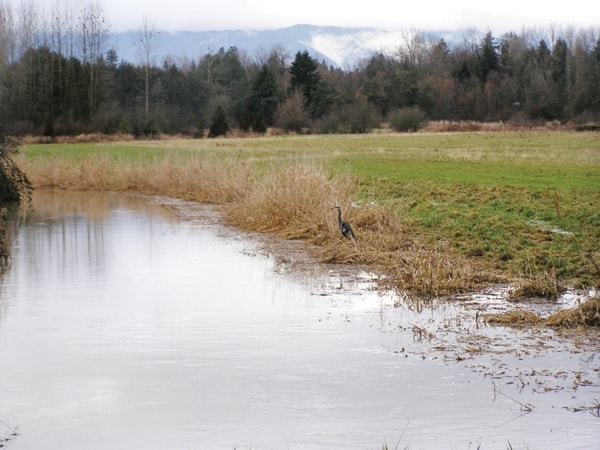Albion flats could see a neighbourhood pub, a farmer’s market, a 100-plot community garden and a community centre, all located next to big-box stores.
Council has added such features on to its vision for Albion flats. The plan calls for major shopping and business parks on the west side of 105th Avenue, with recreation, agricultural activities and residential on the east.
Now council wants to see what the public thinks about it all at an open house March 30, once it clarifies how much land actually could be removed from the Agricultural Land Reserve.
“We really need clarity around that,” said Coun. Cheryl Ashlie, supporting a point made by Couns. Al Hogarth and Mike Morden.
Up to 67 per cent of the area could be used for conservation or recreation, Hogarth said.
Creek setbacks that protect the shoreline areas throughout the flats will also reduce the amount of land that can be developed.
“So, really, how much land are we talking about that’s in the ALR that can be effectively farmed or producing food?” Hogarth asked at Monday’s workshop meeting.
The figures provided in a staff report also bothered Coun. Michael Morden, who also called for a clearer explanation of the area and its existing and potential uses.
“To me, this chart was very confusing.”
According to one of the background reports, the total area of Albion flats is 311 acres, of which 89 per cent (275 acres) is in the Agricultural Land Reserve.
But if property is excluded from the land reserve, then urban regulations that protect streamsides would apply. According to consultant HB Lanarc, land-use changes could see 121 acres, or 38 per cent of the Albion flats, allotted for streamside protection.
Details of the additions include locating the pub near 240th Street and Lougheed Highway, which has been identified as a commercial/residential node with transit service.
That area could be located next to a new West Coast Express commuter rail station on the south side of Lougheed Highway, if TransLink ever decides to do that.
The agricultural fairgrounds, on the present site of the Albion fairgrounds, could include a farmer’s market, restaurant, barns, a training and research farm, compost, and a food education institute.
After the open house, council will consider input from that at its May 2 meeting, then send the draft concept plan for Albion flats to the Agricultural Land Commission its comment.
Included in that presentation will be information on how other municipalities deal with removing farmland from the Agricultural Land Reserve and some options on what Maple Ridge could do to offset land that would be removed.
Council heard that Surrey requires twice the amount of land to go into the land reserve for any portion that is taken out for development.
Coun. Craig Speirs said it should be three-to-one or four-to-one ratio. He criticized the plan for trying to jam too many uses into the area.
“Where’s the kitchen sink? It’s not here anywhere – and don’t they vote?
“I don’t support any part of this. It’s really wrong-headed,” Speirs said.
“My opinion is, we’re going to do what the community wanted us to do,” countered Mayor Ernie Daykin.
There’s nothing to say it’s etched in stone. It’s a concept.”
Speirs wanted all four scenarios considered at the open house, but Ashlie said only the scenario chosen by council will be reviewed at the public meeting.
“The structure of the meeting should be focused on where we’re at today, not where we were before.”
A final Albion area plan won’t likely be finished until next winter.
After the public meeting on March 30, it should take the land commission all summer to give its comments.
From those, Maple Ridge district will prepare a farmland exclusion application, to public hearing in September.
The exclusion application itself won’t go to the land commission until October or November. That will be accompanied by the concept plan for the area. If the ALC approves the exclusions, developers would then propose projects that are consistent with the plan.
